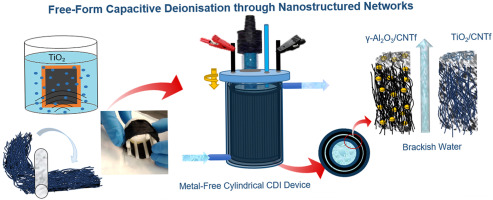Patent details
Status
Patent application in Spain
Publication number
P201730828
Priority date
22 June 2017
Inventors
Juan José Vilatela, Cleis Santos Santos, Enrique García-Quismondo Hernáiz, Jesús Palma del Val
Applicant
IMDEA Materials Institute, IMDEA Energy Institute
Transfer opportunity
License of technology
Context
The availability of affordable clean water is one of the key technological, social, and economical challenges of the 21st century. As a consequence, there is a large interest in the development of desalination technologies. Capacitive Deionization (CDI) has emerged over the years as a robust, energy efficient, and cost effective technology for desalination of drinking water. Accordingly. CDI is strongly considered as a versatile technology for desalination able to address the water-energy nexus challenge.
Description
Electrode for capacitive deionization in which the active phase and the current collector are included in a single element, i.e. a hybrid material. The fabrication of electrodes is based on the continuous impregnation of CNT fibres with metal oxide precursors in-line as they are spun from the chemical vapour deposition reaction, followed by calcination. Consequently, the electrode of the present invention has a reduced contact resistance and improved charge capacitance which leads to more
efficient capacitive deionization systems.
The electrode of the present invention presents a better performance as a result of the synergistic effect between both components of the hybrid material, i.e. the carbon nanotube fibers and the metal oxide coating. The fibers of carbon nanotubes constitute a network that guarantees the properties of electrical conductivity so that they not only act as a current collector but also allow establishing the electrical connection between the coating of metal oxides that is not conductive, but it also has textural and electrochemical properties of interest for capacitive deionization.

Technology advantages
The remarkable efficiency obtained is due to the morphology of the electrodes, in which the CNT fibres act simultaneously as a current collector, active material and support for the metal oxide. Such architecture leads to high capacitance while minimizing internal resistance.
Large salt adsorption capacity of 6.5mgg−1 from brackish water (2.0gNaClL−1) and very high efficiency of 86%, which translates into a low energy consumption per gram of salt removed (∼0.26Whg−1).
This is an 80% improvement compared with reference devices based on activated carbon electrodes and titanium foil current collectors.
Simple fabrication process that enables fabrication of large electrode samples.
The high conductivity and flexibility in bending of the CNT fibre fabrics opens the possibility to make current collector-free electrodes with complex non-planar shapes.
Relevant publications
[1] Interconnected metal oxide CNT fibre hybrid networks for current collector-free asymmetric capacitive deionization
Cleis Santos, Julio J. Lado, Enrique García-Quismondo, Inés V. Rodríguez, Daniel Hospital-Benito, Jesús Palma, Marc A. Anderson and Juan J. Vilatela
J. Mater. Chem. A, 2018,6, 10898-10908. DOI: https://doi.org/10.1039/C8TA01128A
[2] Low-energy consumption, free-form capacitive deionization through nanostructured networks
Cleis Santos, Inés V. Rodríguez, Julio J. Lado, María Vila, Enrique García-Quismondo, Marc A. Anderson, Jesús Palma, Juan J. Vilatela
Carbon, Volume 176, May 2021, Pages 390-399. DOI: https://doi.org/10.1016/j.carbon.2021.01.148
Contact
Technology Transfer and Innovation Office, IMDEA Materials Institute
email: techtransfer.materials@imdea.org
telephone: +34 91 5493422

